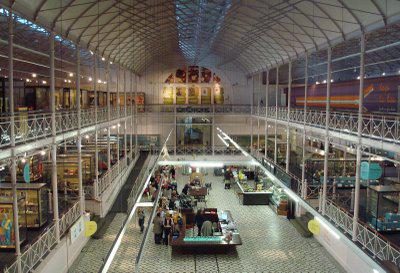
Behind its new facade, the Museum of Childhood's building is an interesting piece of Victoriana in its own right. Its iron frame was originally part of the V&A's first, temporary building in South Kensington, and moved to the East End in 1866 to house a trade museum. The ground was purchased using subscriptions from local residents; the iron frame was filled in with red brick and panels illustrating various trades.

 Inside, the marble mosaic 'fish scale' floor was made by women from Woking Gaol . The full title of the gaol was the 'Woking Invalid Convict Prison', and it was designed to house those suffering from mental or physical disabilities. The prison had a specialist Mosaics Department whose women earned 1s 2d a day breaking marble for the mosaics. As well as the Bethnal Green floor and work in South Kensington, they also provided a mosaic floor for the crypt of St Paul's Cathedral.
Inside, the marble mosaic 'fish scale' floor was made by women from Woking Gaol . The full title of the gaol was the 'Woking Invalid Convict Prison', and it was designed to house those suffering from mental or physical disabilities. The prison had a specialist Mosaics Department whose women earned 1s 2d a day breaking marble for the mosaics. As well as the Bethnal Green floor and work in South Kensington, they also provided a mosaic floor for the crypt of St Paul's Cathedral.Bethnal Green Museum was opened by the Prince and Princess of Wales in 1872, and proved a great success with 1.5 million visitors in the first year. Permanent collections of food, animal products and French art combined with temporary visits by the Wallace, National Portrait and Pitt Rivers collections. The food collectio
 n had moved from the main museum and was 'arranged with the express object of teaching the nature and sources of food, representing the chemical composition of the various substances used as food, and the natural sources from which they have been obtained.' Admission to all this was free every day except Wednesday.
n had moved from the main museum and was 'arranged with the express object of teaching the nature and sources of food, representing the chemical composition of the various substances used as food, and the natural sources from which they have been obtained.' Admission to all this was free every day except Wednesday.However, in the 1920s director Arthur Knowles Sabin began to shift the focus towards children, with exhibits and activities designed for them and the development of a children's collection. This eventually led to the Bethnal Green Museum's transformation in 1974 into the Museum of Childhood.

